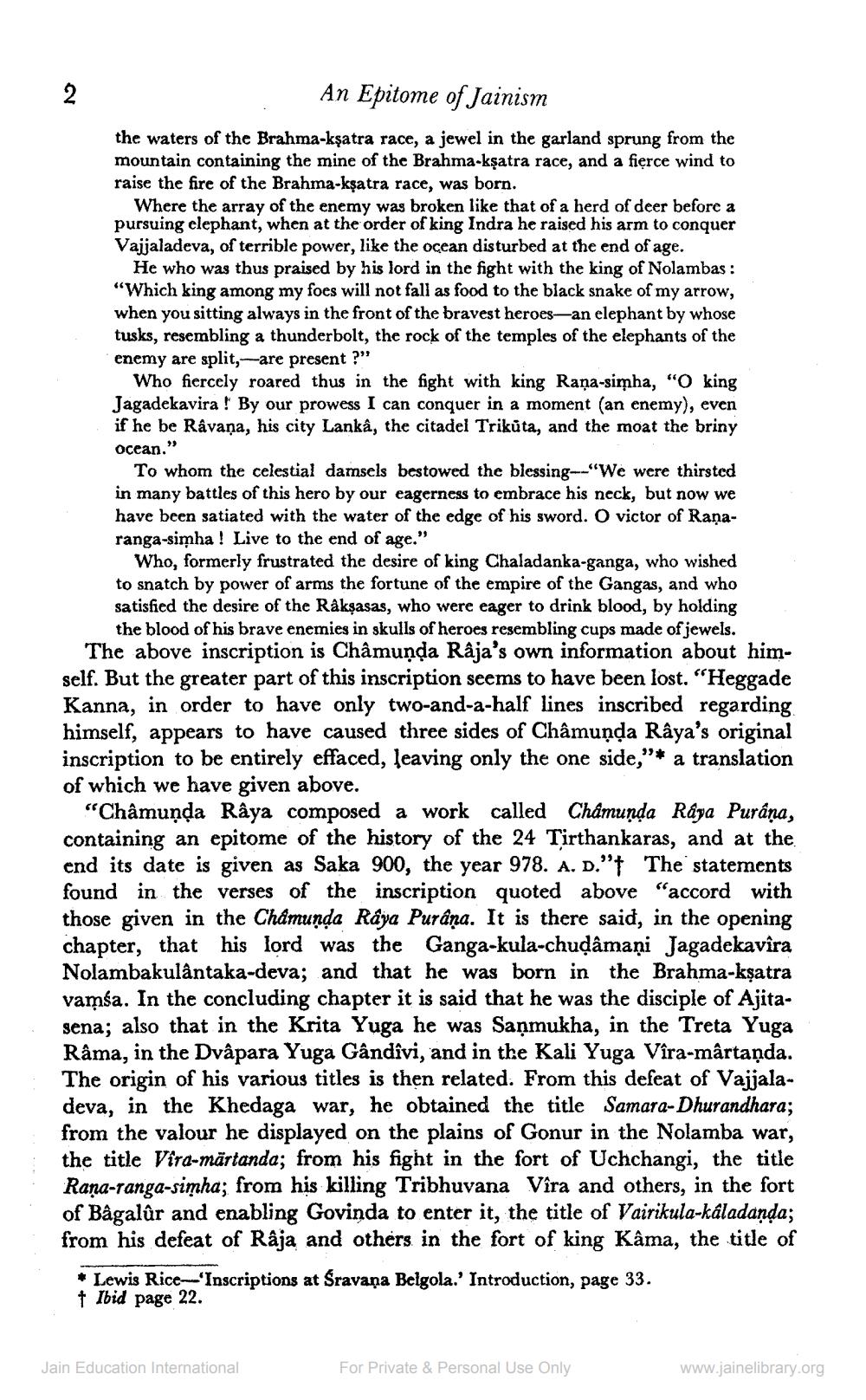________________
2
An Epitome of Jainism
race, was be that of abd his arm
the waters of the Brahma-kşatra race, a jewel in the garland sprung from the mountain containing the mine of the Brahma-kşatra race, and a fierce wind to raise the fire of the Brahma-kşatra race, was born.
Where the array of the enemy was broken like that of a herd of deer before a pursuing elephant, when at the order of king Indra he raised his arm to conquer Vajjaladeva, of terrible power, like the ocean disturbed at the end of age.
He who was thus praised by his lord in the fight with the king of Nolambas: "Which king among my foes will not fall as food to the black snake of my arrow, when you sitting always in the front of the bravest heroes—an elephant by whose tusks, resembling a thunderbolt, the rock of the temples of the elephants of the enemy are split,--are present ?”
Who fiercely roared thus in the fight with king Raņa-simha, "O king Jagadekavira ! By our prowess I can conquer in a moment (an enemy), even if he be Ravana, his city Lanka, the citadel Trikůta, and the moat the briny ocean."
To whom the celestial damsels bestowed the blessing--"We were thirsted in many battles of this hero by our eagerness to embrace his neck, but now we have been satiated with the water of the edge of his sword. O victor of Raņaranga-simha ! Live to the end of age."
Who, formerly frustrated the desire of king Chaladanka-ganga, who wished to snatch by power of arms the fortune of the empire of the Gangas, and who satisfied the desire of the Råkşasas, who were eager to drink blood, by holding
the blood of his brave enemies in skulls of heroes resembling cups made of jewels. The above inscription is Châmunda Raja's own information about himself. But the greater part of this inscription seems to have been lost. "Heggade Kanna, in order to have only two-and-a-half lines inscribed regarding. himself, appears to have caused three sides of Châmunda Râya's original inscription to be entirely effaced, leaving only the one side,"* a translation of which we have given above.
"Châmunda Râya composed a work called Chamunda Raya Purana, containing an epitome of the history of the 24 Tirthankaras, and at the end its date is given as Saka 900, the year 978. A. D.'+ The statements found in the verses of the inscription quoted above "accord with those given in the Chamunda Raya Purâņa. It is there said, in the opening chapter, that his lord was the Ganga-kula-chudâmaņi Jagadekavîra Nolambakulântaka-deva; and that he was born in the Brahma-kşatra vamsa. In the concluding chapter it is said that he was the disciple of Ajitasena; also that in the Krita Yuga he was Saņmukha, in the Treta Yuga Râma, in the Dvâpara Yuga Gândîvi, and in the Kali Yuga Vîra-mârtaņda. The origin of his various titles is then related. From this defeat of Vajjaladeva, in the Khedaga war, he obtained the title Samara-Dhurandhara; from the valour he displayed on the plains of Gonur in the Nolamba war, the title Vira-märtanda; from his fight in the fort of Uchchangi, the title Rana-ranga-simha; from his killing Tribhuvana Vîra and others, in the fort of Bagalûr and enabling Govinda to enter it, the title of Vairikula-kaladanda: from his defeat of Raja and others in the fort of king Kâma, the title of
* Lewis Rice-'Inscriptions at Sravana Belgola.' Introduction, page 33. † Ibid page 22.
Jain Education International
For Private & Personal Use Only
www.jainelibrary.org




